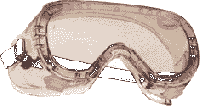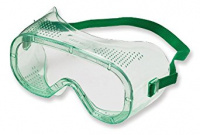Safety Glasses
Science Olympiad has provided definitions of the various kinds of safety glasses that are to be used in events. This policy was recently revised for the 2016 and future seasons, in which eye protection is divided into three categories. This page gives an overview of the current classes of eye protection, as well as pictures. However, be sure to read the official Science Olympiad, Inc. policy page as well.
The rules manuals state the category of eye protection that is acceptable for each event, usually under rule 1, near the top of the rules page for each event.
In order to be approved for use in Science Olympiad, safety spectacles must meet the ANSI standard at the time of their manufacture, bearing the manufacturer's "Z87" or "Z87+" mark. Removable lenses must also bear the "Z87" mark. In general, regular eyeglasses, whether with or without special safety glass, are not approved unless they bear this mark.
Please note that the pictures may not necessarily show glasses that are actually ANSI rated. They were merely chosen for visual similarity to the classes listed at soinc.org.
Category A
| Description | Images | ||
|---|---|---|---|
| In order to meet the requirements of Category A eye protection, safety spectacles must provide basic particle protection. Examples include safety glasses, safety spectacles with side shields, and particle protection goggles. | |||
| Safety glasses which fulfill the criteria of Category A eye protection | Safety glasses with side shields meet requirements of Category A eye protection | An example of particle protection goggles, which meet the specifications of Category A eye protection | |
Category B
| Description | Images |
|---|---|
| In order to fulfill the criteria of Category B eye protection, safety spectacles must provide protection from high inertia particle hazard (often referred to as high impact protection). As such, they must bear the "Z87+" marking. Category B eye protection is also acceptable for events which require category A, since Z87+ is a higher standard of protection than Z87. | |
| An example of goggles which protect from high inertia particle hazard, therefore meeting the requirements of Category B eye protection |
Category C
| Description | Images | ||
|---|---|---|---|
| To meet the requirements of Category C eye protection, safety spectacles must provide indirect vent chemical/splash protection. They must seal tightly to the face completely around the eyes. Indirect vents must be constructed in a way so that there is no direct path for foreign matter to enter the eyes. As per the second section of the eye protection policy, Category C goggles must also bear the ANSI Z87 mark.
The national organization eye protection policy explicitly states that although VisorGogs do not seal completely to the face, they are acceptable as indirect vent chemical/splash protection goggles, and therefore are suitable as Category C eye protection. |
|||
| An example of goggles which provide indirect vent chemical/splash protection, therefore meeting the criteria of Category C eye protection | Note the indirect vents (black knobs), which eliminate any straight line path for liquids to enter the eye | These goggles have direct vents, and therefore DO NOT meet category C eye protection | |
Other Information
The "Z87" mark, which all acceptable eye protection must bear, indicates basic particle protection. This is the distinguishing feature of Category A and a requirement of Category C. A "Z87+" mark indicates impact protection, and is the distinguishing feature of Category B. Goggles that bear the "Z87+" marking and provide indirect vent chemical/splash protection meet the criteria for all three categories. As such, they may be used for any event which requires eye protection.
In most cases, a determination of what constitutes hazardous is left to the individual event supervisor, who is considered to be in the best position to make that determination. However, the eye protection policy explicitly states that water is not considered a hazardous material, and on its own, unpressurized water does not require protective eyewear.
Contestants must not be allowed to participate without the level of protection required by the rules. It is sometimes impossible for event supervisors to know what hazards a team's device may present; therefore, it is incumbent upon teams to bring and wear a higher level of protection than what is specified in the rules when their device warrants it.
Events that Require Safety Glasses
2020 Events
Category A
- Division B:
- None
- Division C:
- None
Category B
- Division B:
- Division C:
Category C
- Division B:
- Division C:
2019 Events
Category A
Category B
Category C |
2018 Events
Category A
Category B
Category C |
2017 Events
Category A
Category B
Category C |
2016 Events
Category A
Category B
Category C
By Event
|
Past Policy
In the past, the eye protection policy used numbered classifications, Type 1 through Type 5. This system was replaced and simplified prior to the 2016 season. In addition, several events that previously required eye protection have had that requirement removed.









